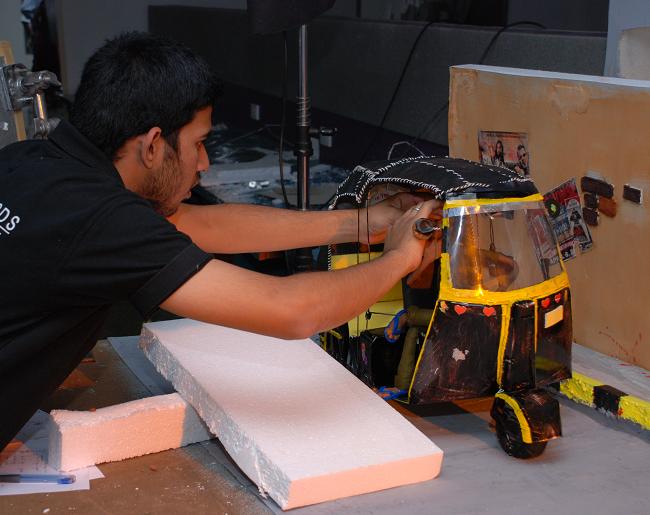The word education gets its origin from the Latin word ?duc?ti? which means bringing up or rearing. We have always been told by our elders that if you want to be successful in life you need to attain the right education. Well, if you felt that being successful in the animation, gaming or visual effects field didn’t require one to follow this advice then you are mistaken.
For long the Indian animation industry has been criticised for being more of a sweat shop or a back office for behemoths from across the globe, but that trend is changing now and how! Much of that change needs to be attributed to the way the fields of animation, visual effects and gaming have slowly but steadily earned respect from all quarters.

The young brave hearts who once faced the flak for being ‘creative rebels’ by the society are now being seen as the torch bearers for taking the AVGC industry to a global level of dominance. Who would have imagined that a small post-production set-up running out of a small garage space will one day go onto become one of (if not) the largest VFX and post-production facility globally called Prime Focus.
Things are a lot different now and the animation, visual effects and gaming verticals of the AVGC industry have come a long way; even as it has evolved over the past few decades and adapted a few best practices by mimicking some great creative geniuses from the Western world, there is a lot more impetus that is being given to specialised training and courses to better equip individuals who are wanting to venture into this space.
In this special report, AnimationXpress.com will attempt to bring forth some insights from the current education scenario prevailing in the country and what can young minds expect from the industry and likewise what are the ingredients that the industry looks for in a fresher.
Horses for Courses:
As one would have noticed in the recent ad campaign by Amazon India, which is running across all channels on television, Indians are never happy with what’s on offer and always demand ‘Aur Dhikhao… Aur Dhikhao’. This mentality is very much prevalent in major education centres across the country as well, since most of them believe in quantity rather than quality when it comes to honing the nascent talent among young minds.
However, there are a few exceptions to this phenomenon. The Anibrain School of Media Design for example which is based in Pune offers only four courses namely: VFX for Films (10 months); 3D for VFX (12 months); Diploma in VFX and 3D (2 Year – Dual Internship) and the recently introduced Game Design & Game Development course (13 months).
 “We primarily provide internship to our students at Anibrain VFX studio, where they get their first exposure to the studio environment and rigorous production process. Our students have been placed with leading animation studios like Anibrain VFX, Montura VFX, Trace, Prana Studios, Bubble Creation, Deluxe, Digikore, Tool Box studios and more,” reveals Anibrain School of Media Design founder Jesh Krishna Murthy.
“We primarily provide internship to our students at Anibrain VFX studio, where they get their first exposure to the studio environment and rigorous production process. Our students have been placed with leading animation studios like Anibrain VFX, Montura VFX, Trace, Prana Studios, Bubble Creation, Deluxe, Digikore, Tool Box studios and more,” reveals Anibrain School of Media Design founder Jesh Krishna Murthy.
Currently, more than 150 students have been enrolled this session, with over 120 students having successfully completed their respective courses and working in reputed companies now.
One of the other leading Animation and VFX educators in the country – MAAC – too offers two full-time courses. “Animation is our flagship course AD3D Edge, which is a two-year programme delivered three days a week, two hours a day. Whereas, for visual effects we offer ADVFX which is again a two-year program delivered three days a week two hours a day,” expounds MAAC (India), Sr. VP Shajan Samuel.
Another institute that is primarily known to house film aspirants in general, also ventured into education for the animation vertical of the media and entertainment industry. The institute in question is the brain child of renowned filmmaker Subhash Ghai – Whistling Woods International, which offers a three-year intensive course in B.sc/BA in animation filmmaking.

The course deals with topics ranging from the history of art and animation to the latest techniques of photorealistic computer generated imagery (CGI). The course informs students about theatre and its evolution, music, production design, creative writing, visual storytelling, film history and culture studies as part of its contextual studies or general education program.
School of Animation – head of academics, Yusuf Mehta says: “The curriculum that is designed is very generic but has been evolving with the industry requirements. We believe the basics are fundamental in making a strong base for processes rather than technology. There is a variety of pipelines that are prevalent in the market, thus as an educational institution it is essential to equip them to understand the concept, principles and processes better.”
Zee Institute of Creative Art (ZICA) is another full-fledged classical and digital animation training academy that trains youth in classical 2D and modern 3D animation. The past seventeen years has seen the institute nurture some of the brightest talents in the animation space. The institute has adopted a novel training style and is focused entirely on creating a stimulating environment for its students.

The courses currently on offer are, a Diploma in Animation & VFX, a Diploma in VFX Film making, a Diploma in Visual Effects, a Certificate in 3D Animation Production, a Certificate in Graphic Design, a Certificate in Web Design, a Specialisation in Animation (3D Character Animation), a Specialisation in Visual Effect. And apart from these there are also other modular courses/software based courses that include Maya, Photoshop, Z Brush, After Effects, Nuke, Fusion, Dreamweaver, CorelDraw, HTML5, Flash, among others.
“The objective behind these courses is to get the students industry ready and this will help them to get a good exposure to fundamentals of Animation, VFX, Graphic and Web design and Game Design,” ZICA, ZIMA & Zee Learn – business lead, Praveen Gadelli.
Train the Trainers:
A teacher is someone who is entrusted with the formative years of a child, thus is responsible for the holistic development of his/her core skill-set along with the soft-skills that he/she picks up along the way.
Similarly, when talking about the kind of training that is imparted in these institutions; the teacher/trainer needs to be equipped, rather armed with the right ammunition, so that the child is well trained to enter the battlefield of sorts, when he enters the AVGC arena.

Most of the training institutes – in this field – that are functioning in the country today maintain a standard ratio of 1:10 for teacher to student, which aides in better learning through a more personalised touch. There is also a healthy mix of full-time faculties along with many industry professionals coming in as visiting faculties for all major courses. Institutes generally take on faculties who are industry professionals, with some experience of working in the related industry as it is believed that they have a better capability of understanding the industry requirements and can ensure that the learning quality matches that of what is in demand at the industry level.
It is important that students are assured of creative exposure with a healthy mix of theory and practical sessions, delivered with the right amalgamation of art and technology, under the supervision of in-house experienced faculties and industry experts from not only India, but also international talent.
Need of the Hour:
One may ask what all this training is worth if they don’t meet the industry requirements. Well, that is precisely what we found out from leading animation and visual effects houses in the country, to better understand how the institutes can further enable their prospective candidates for these leading post-production and studio facilities.
Prime Focus, co-founder & chief creative director, Merzin Tavaria says: “The VFX industry is highly volatile and it’s not just learning or training that helps us, but also the experience that we gather along the way. I believe what’s holding back the industry is the fact that students are not getting an opportunity to work on major VFX projects; at Prime Focus a fresher gets to work alongside seniors on projects like an Avatar or Tron: Legacy. I think we have the talent, it’s all about presenting them with the right opportunity.”
Maya Digital Studios, chairman & MD, Ketan Mehta expounds: “We started Maya In Studio Training (MIST) because we could see the lack of studio readiness among young trainees who came in looking for opportunities. Thus, we took the onus of teaching the processes of production, so as to make these candidates ready for the industry as the course works like an apprentice programme, wherein they get to work on live projects as part of their learning.”
Prime Focus and Maya Digital Studios are pioneers and leaders in their respective fields of expertise and these views coming from industry leaders is testament to the fact that renowned studios are open to taking on board a fresher to work on assignments if they are keen on going the extra mile and taking on more responsibility.
Thus, training institutes should take a cue and implement certain best practices like, constant industry feedback should be taken to keep the course and content updated as per industry norms; a project based approach should be taken by the institute to ensure the student’s skills are sharpened; soft skill training should be imparted to the student as well and more workshops and seminars should be conducted so that they stay updated with the industry requirements.
Show me the Money:
After all the intensive training and long hours in front of the computer screens, there needs to be some incentives coming your way too, right? Well, there is some good news and some bad news for those getting into this field as full time professionals.
To start off, the bad news is you will be paid peanuts when you begin working as a trainee or a fresher in any of the leading VFX and animation houses in the country; it’s not because they don’t value your contribution, but simply because that’s the way most industries function. You have to work your way up the value chain to reach the pinnacle of fame and fortune.
 Now, for the good news… you may feel you have been undervalued when you start off early in your career, but as and when you gain the right experience and continue building a strong portfolio or showreel in most cases, you can quickly scale up and charge great value for the work done by you and once people are aware of the skills that you bring to the table you get to decide your price and most of the time than otherwise, you will be signed on without any negotiations.
Now, for the good news… you may feel you have been undervalued when you start off early in your career, but as and when you gain the right experience and continue building a strong portfolio or showreel in most cases, you can quickly scale up and charge great value for the work done by you and once people are aware of the skills that you bring to the table you get to decide your price and most of the time than otherwise, you will be signed on without any negotiations.
“After the completion of a two-year program both in visual effects or animation the starting salary can be anywhere between Rs 13,000 – Rs 20,000, but in this industry starting salary doesn’t matter, the candidate can scale up quickly and move up the value chain if he has the skills and can put on show the application of those skill-sets,” informs MAAC (India), Sr. VP Shajan Samuel.
Futurama:
As we come to the end of this special report by AnimationXpress, we look into the future of this industry and see a bright light at the horizon. There have been many announcements in the recent past for having national centres of excellence in animation, visual effects and gaming at various pockets in the nation; various state governments like the one in Karnataka and Maharashtra are showing keen interest in uplifting the AVGC ecosystem in general by introducing a more conducive state policy for studios and individuals in this field.
According to the recent FICCI-KPMG study, 2014 saw the value of VFX grow the highest at 22 per cent, followed by post-production at 15 per cent, animation production at 9 per cent and animation services at 1 per cent. An overall 13 per cent growth from Rs 39.7 billion in 2013 to Rs 44.9 billion in AVGC sector in 2014 was majorly due to the unpredictable changes that came about last year.

Going ahead, the demand is more for generalists now. No longer are there requirements for only modellers, riggers or roto artists; thus institutes need to focus at honing overall skills of the young minds. There is a lot of scope in gaming, advertising and education fields, where there is a dearth of the right talent.
There is an interest coming back into 2D animation, which is an encouraging sign after witnessing a renaissance of 3D animation. Some students are interested in the design aspect of things now; like character design, concept art, production design and pre-visualisation, which only goes onto show that they are reading and coming to know a lot more of the various expertise skills that are required and more relevant in today’s day and age.
The day when India too can claim to have a unique style of animation, film-making, game art or comic design; that will be the day when we can take a bow for the great training and educational centres that we have in the country, which have honed and groomed the skills of a natural talent, who will put India on the global map; not for being the back office of a global animation or VFX house, but for the sheer talent and skills that we possess as a nation.
